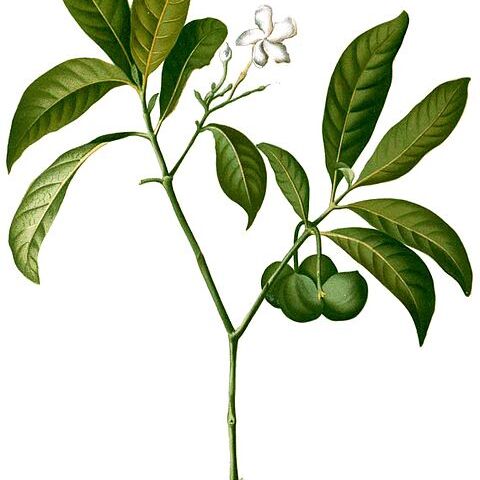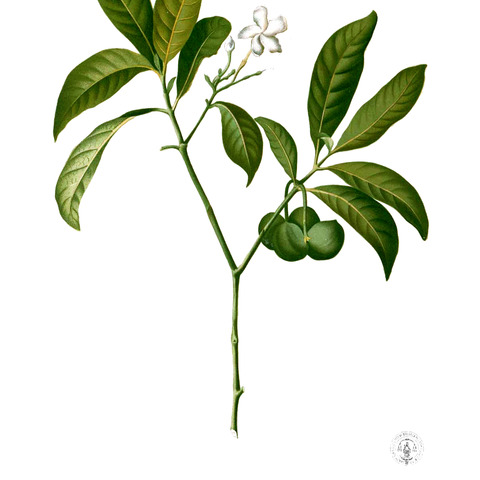Shrubs or trees with dichotomous branching; with white latex in all parts; trunk without buttresses. Leaves opposite; petiole bases joining to form short ocrea, these sometimes obscure especially in older leaves. Inflorescence a cyme or solitary flower, lax; 2 inflorescences at each ramification; flowers usually fragrant. Sepals in most species with a distinct connate tube and free lobes; usually with colleters inside; shed with the corolla. Corolla lobes sinistrorse; mature corolla with narrow or trumpet-shaped tube and spreading lobes. Stamens subsessile; completely included in tube or slightly exserted; anthers narrowly triangular, base sagittate, apex acuminate, sterile at apex; weakly attached to the style head. Disk adnate to sides of carpels. Gynoecium 2-carpellate, apocarpous but apically united into a common style; style filiform; style head short. Fruit of paired follicles, usually somewhat united at least at base. Seeds covered in a fleshy aril.
Trees or robust erect shrubs, latex present, branches dichotomous. Leaves opposite; petioles or leaf bases of a node often connate into a short ocrea, with a single row of colleters in axils. Cymes terminal, pedunculate. Flowers often fragrant. Calyx campanulate to cylindric, with many basal glands inside. Corolla white or yellow, salverform, large, tube widened at base and at or above middle, shorter or only slightly longer than calyx, throat with a fleshy ring, not scaly, lobes spreading or recurved, overlapping to left. Stamens inserted in distal widening of corolla tube, exserted or included; anthers sessile, sagittate, coherent to pistil head; disc ringlike or of five lobes adnate to ovaries. Ovaries 2, free or fused basally; ovules numerous. Pistil head lampshade-shaped, apex shortly 2-cleft. Follicles 2, pendulous. Seeds numerous, embedded in pulp, not comose.
Perennial shrubs or trees, evergreen; latex white. Stems without spines. Leaves petiolate, opposite; lamina entire, coriaceous, glabrous or with simple basifixed hairs; colleters absent. Inflorescences terminal, cymose, pedunculate. Flowers scented, pedicellate. Calyx with colleters. Corolla salverform; tube narrowly cylindrical to cylindrical, twisted, internally glabrous, lacking scales; lobes sinistrorse in bud. Corolline corona absent. Stamens exserted or included, inserted in upper part of tube, not adherent to style-head; anthers narrowly triangular. Disc an annular ring or variously lobed. Style-head obovoid. Fruit syncarpous, a fleshy paired follicle. Seeds numerous, reniform to ellipsoidal, arillate, unwinged, ecomose.
Pistil glabrous; ovary mostly broadly ovoid; carpels free or connate at the base, surrounded by a ring-shaped entire or lobed disk; disk adnate to the abaxial sides of the carpels; style thickened at the apex; clavuncula with a thin, recurved, undulate, entire, or lobed ring at the base, obovoid with 5 short lateral lobes, coherent with the connectives of the anthers.
Seeds surrounded by a yellow or orange pulpy aril, usually numerous, large, obliquely ellipsoid or less often reniform, at the hilar side with one deep groove to half their width, less deeply grooved at the other sides, with a minutely tuberculate or honeycomb-like structure; endosperm copious, starchy, creamy to white, ruminate, surrounding the spathulate embryo.
Leaves opposite, those of a pair equal or unequal, usually petiolate; petioles or leaf bases of a pair connate into a short ocrea, with a single row of colleters in the axils; lamina elliptic or obovate or narrowly so, cuneate at the base or decurrent into the petiole.
Corolla mostly creamy or yellow; tube shorter or (in the species of the F.Z. area) only slightly longer than the calyx, twisted, variously shaped; lobes in bud overlapping to the left, spreading or recurved.
Fruit two free or less often partly or completely united carpels (the latter not in the F.Z. area); wall soft, carnose, often thickish, creamy or yellow.
Shrubs or trees, repeatedly dichotomously branched and with bark usually with some white latex; 2 inflorescences in the forks when flowering.
Stamens exserted or included; anthers sessile, narrowly triangular, acuminate at the sterile apex, sagittate at the base, glabrous, introrse.
Inflorescence in the forks of branches usually long-pedunculate, corymbose, usually rather lax.
Calyx green, campanulate to cylindrical, usually shed with the corolla, with colleters inside.
Bracts deciduous or less often (not in the F.Z. area) more or less persistent.
Branchlets terete, mostly deeply sulcate when dry, with white latex.
Style and stigma shed together with the corolla; stigma short.
Flowers actinomorphic, often fragrant.


